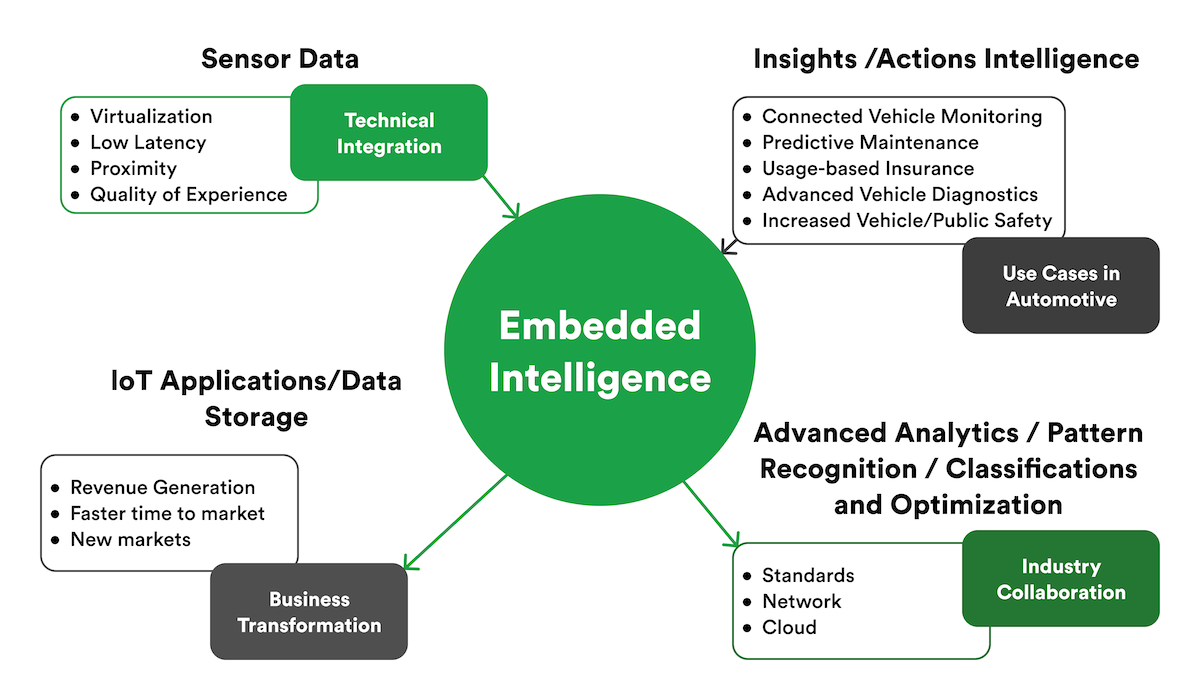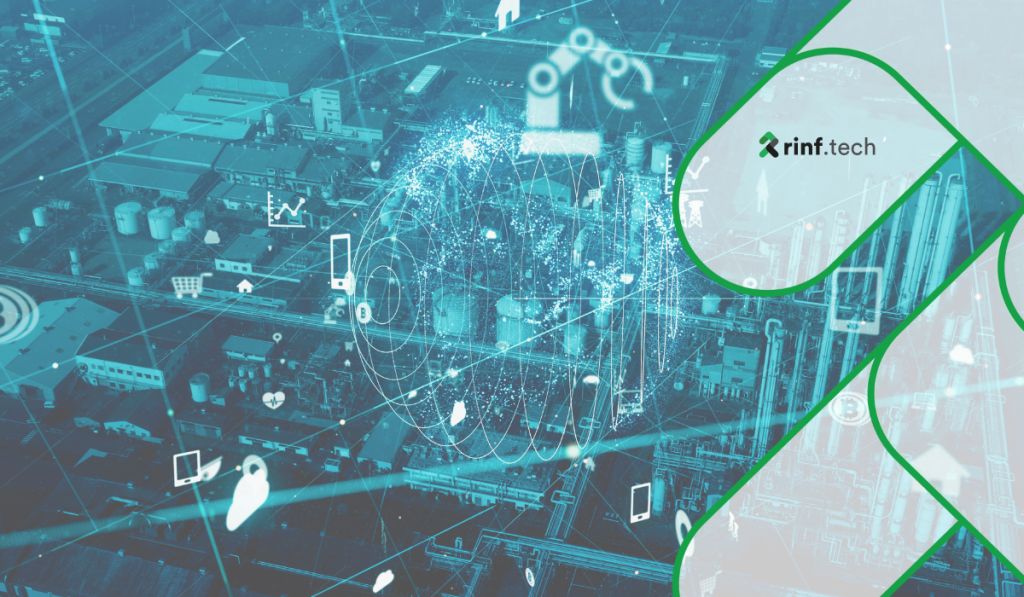
How IoT is Revolutionizing Agriculture: Key Innovations and Future Prospects
Discover how IoT is transforming traditional farming through key innovations, real-world success stories, and future trends that are shaping the agricultural sector.
These are some key areas that businesses typically focus on when analyzing the efficiency of their operations. Insights from these assessments can reveal the need for high-level optimization as well as the most minute and intricate reconfigurations. If there’s any room for improvement, organizations have to act at breakneck speeds to stay fiercely competitive, increase profit margins, and future-proof themselves.
Embedded intelligence is an ultramodern solution for the assessment of operations, and in particular, self-assessment. It is a technology where systems can analyze and assess their own performance. The world is accelerating at alarming speeds and organizations need to be able to keep up. Embedded intelligence could be the perfect solution for companies worldwide.
The potential of embedded intelligence hasn’t gone unnoticed. Innovators and early adopters have seen profound success with embedded intelligence, and that’s prompting other companies, especially those in the technology industry, to explore it. Embedded intelligence could be a primary competitive differentiator in the future.
The global embedded intelligence market is set to attain a value of $82,215 million by 2032. This is predicted to grow at a compound annual growth rate of 13% since 2022. This is going to be the decade of embedded intelligence, especially for North American and European markets.
Before delving into how tech leaders can adopt and leverage this high-potential technology, it’s vital to internalize what embedded intelligence involves and what its primary advantages are.
Embedded intelligence is when a system has the unique capability to self-evaluate. A “system”, in this context, could range from products, services, processes, protocols, hardware, software, and everything in between. Companies can use the insights gathered from embedded intelligence to make faster and smarter decisions for holistic business improvements.
Analytics has been around for a long time. With a potential value of $655.53 billion by 2029, the big data analytics market is a giant. Embedded intelligence has a unique place within data analytics. While embedded intelligence also mines vast amounts of data to generate actionable business insights, there is a distinct difference in how it conducts that work.
Embedded intelligence has its capabilities ingrained and deeply rooted in a system. Therefore, its proximity to data sources is as close as it can get. Other forms of data analytics often take place in different environments and far away from data sources. Both options have great potential but embedded intelligence has a few unique benefits that tech leaders need to be aware of.
One of the key drivers for embedded intelligence is the rise in internet-of-things (IoT) devices. IoT refers to a network of smart devices that are connected to communicate, collaborate, and exchange information with one another.
By 2030, there are likely to be more than 29 billion IoT devices in existence. As of 2020, there were only 9.7 billion IoT devices, which highlights the staggering rate of growth, innovation, and adoption. Many of these devices will be applied in a business or industrial context. This makes embedded intelligence a leading technology in this upcoming chapter of the 21st century.

Embedded Intelligence in Automotive
The adoption of embedded intelligence will automatically lead to the creation and development of a thriving data-driven culture. This means that an organization that employs embedded intelligence will immediately benefit from the highly-contextualized and accurate data that is being collected and assessed from sources within the organization’s environment itself.
Tech leaders can make more confident decisions with embedded intelligence. Embedded intelligence will also remove risk from seemingly out-of-the-box business maneuvers because all decisions will be strongly supported by inarguable insights from in-house data. This strong data culture, paired with intuitive and innovative tech teams, can be profoundly transformative.
It’s globally acknowledged that data is the most important asset for businesses. Data management is a top priority for organizations in every industry. However, a mere acknowledgment of the importance of data is insufficient to create significant and lasting change. Gigantic volumes of data that lack context do little to help businesses.
Embedded intelligence provides data-driven insights that directly acknowledge an organization’s business goals, architecture, workflows, strategies, and resources. Therefore, businesses are significantly less likely to be distracted or misdirected by irrelevant data that lacks context. Embedded intelligence reminds businesses that data on its own isn’t the most important asset. High-quality, relevant data is.
Tech leaders know that if their companies face hurdles and bottlenecks between a product or service design and its release into the market, they are likely to get left behind by competitors. In today’s world, even a slight loss of a competitive advantage gap might prove hard to recover from. It’s immensely important for businesses to reduce their TTM to the absolute minimum.
Embedded intelligence catalyzes nearly every process in a business’s operations. If businesses choose to design their own embedded intelligence, they could suffer the same challenges. However, top embedded intelligence service providers could help them optimize their TTM and innovate and launch new or updated products at greater speeds with no quality compromise.
Employees take longer to sift through and leverage data that is disorganized or lacks context. Even the most talented professionals might be less productive when dealing with questionable data. When this happens, the entire promise and potential of data analytics are lost. Old problems are barely solved and there’s a whole host of new problems to reckon with.
Embedded intelligence empowers in-house teams with data that acknowledge the unique details of their operations. In addition, when data management is built into systems, then employees do not need to undergo training to work across multiple systems or technologies. Embedded intelligence inherently fuses operations with analytics.
Integrating machine learning algorithms into devices is a classic example of the powers of embedded intelligence. The advantages of ML models are multifold but one of the key benefits is that businesses no longer require vast amounts of data storage space. In addition to the cost savings, the lack of storage space also helps them drive sustainability and green initiatives.
ML technology is ideal for identifying trends and commonalities in data. It does so quickly, efficiently, and with minimum human intervention. The integration of ML can be complex. However, the automation-driven benefits are worth the investment. Profound and relevant business insights can be generated in real time with ML, which is a boon for companies.
Consumers use products and services that are powered by NLP almost daily. Virtual assistants, language translation applications, autocorrect, and predictive text in search engines are some everyday examples of NLP. As AI technology advances, the potential of using NLP across diverse industries and contexts grows exponentially. It can be a serious game-changer.
By marrying the nuance of human language with the efficiency of machines, NLP offers companies and their clients the best of both worlds. The power of NLP technology is best highlighted in the recent ChatGPT phenomenon, an AI NLP application that is capable of advanced text and literature generation. NLP is likely to be among the most discussed, useful, and controversial technologies in the upcoming years.
Due to technological complexities, voice data analysis has been a challenge in the past. Now, advanced voice recognition and audio analytics provide organizations with vast banks of usable voice and audio-based data. Depending on their requirements, businesses can mine open-source voice data, commissioned or outsourced voice data, and the voice data gathered from their customers.
Speech synthesis, another exciting example of embedded intelligence, is a technology that enables computers to mimic human speech. Speech synthesis can be used in diverse ways.
This technology is being used in educational contexts, especially to meet the intricate needs of students with learning disabilities. It’s also a tremendously empowering tool for deaf and hard-of-hearing people, as well as those with speech impediments.
Some embedded intelligence leans towards the auditory. Others focus on the visual. Computer vision is an AI technology where computers mimic the capabilities of human vision. This is most commonly seen in technology that is capable of identifying objects, faces, patterns, and other specificities in an image or video. Considering the trillions of pixels of visual data available in the world, the potential of computer vision is endless.
Some common use cases of computer vision include immersive and interactive media, self-driving cars, and facial recognition. In a healthcare context, especially in fields like ophthalmology and cardiology, computer vision actively saves lives and supports healthcare professionals by identifying visual anomalies or patterns in scans, x-rays, and photos.
A few decades ago, most people would have believed that autonomous agents were a work of science fiction. However, the speed at which AI has been advancing has resulted in highly proficient autonomous agents that can be used in diverse contexts. Autonomous agents, as their name suggests, are computer-based entities that can perform certain functions without prompts and interventions.
Autonomous agents currently serve industries like BFSI, manufacturing, healthcare, transportation, and telecom. North America and Europe are frontrunners in the implementation of the deployment of autonomous agents. That being said, the megamarkets of India and China are rapidly catching up. Autonomous agents in rapidly developing countries could be the engines of world growth.
The haphazard adoption and integration of random AI-powered tools are often all flash and no substance. High investments in AI technology without careful strategy or planning can be detrimental to an organization. Therefore, it’s of utmost importance that tech leaders adopt an AI/ML-first mindset before adopting the tools themselves.
AI tools evolve at unbelievable speeds. The most exciting technologies could easily become redundant in weeks. Tech leaders need to view AI as an approach rather than getting too attached to specific tools and technologies. The AI/ML-first approach will broaden the possibilities of innovation and empower companies and their leaders with the confidence to make bold business and tech decisions.
Embedded intelligence is an incredible technology for organizations to leverage but it doesn’t necessarily come cheap or easy. Tech leaders shouldn’t get overwhelmed by the endless possibilities of embedded intelligence. Instead, they should meticulously investigate potential use cases within their organization and choose the right ones.
For example, embedded intelligence could be ideal for customer service, workflow automation, and data analytics. However, an organization, for various reasons, might only be able to apply embedded intelligence in one of these. Tech leaders need to measure the cost and benefits of using embedded intelligence in any of their organization’s verticals. Like any technology, embedded intelligence is only as good as its application.
The availability of data isn’t often the primary challenge for tech leaders. More often than not, the challenge lies in how to leverage that data for business gains. An important step in adopting embedded intelligence is to leverage existing data to its fullest potential before searching for new data sources. New data sources could be massively influential but are perhaps saved for a later stage when organizations are better acquainted with embedded intelligence.
Due to suboptimal strategies and technologies, tech leaders aren’t always cognizant of the quality and potential of the data that they possess. The adoption and implementation of embedded intelligence allow tech leaders to assess their organization’s existing data and utilize that data to its absolute maximum potential. Most companies already have sufficient amounts of high-quality data to make significant gains.
Tech leaders should dedicate a significant portion of their IT budgets to AI and ML projects and resources. The upfront costs of AI technology can often seem daunting. However, it’s important to remember the long-term benefits and transformative potential of these technologies. AI and ML adoption is rarely an overnight success story. Businesses should take small and measured steps toward AI and ML adoption.
Due to the global frenzy around AI, tech leaders may feel the pressure to make such technologies the main characters of their organization’s story. It would be far more pragmatic to view AI as a strong supporting character that, over time, can be nourished and guided to be a foundational pillar of the organization. The first step towards that is making smart and responsible investments in AI and ML projects, tools, and other resources.
Ultramodern technology is always a double-edged sword. In the hands of responsible leaders, embedded intelligence can cause positive and holistic change, not just for organizations but also for their clients, society, and culture. On the other hand, irresponsible use of these technologies can be detrimental to certain sections of society, typically those who have already experienced some form of subjugation.
Ethics will always be discussed in relation to AI, and justifiably so. The ethics of AI has been a subject of discussion since before the technology existed. By employing ethical practices, tech leaders can show the world that AI can serve everyone equally and fairly, rather than providing benefits for a select few and neglecting others parts of society, culture, and the environment.
The adoption and implementation of embedded intelligence can unlock numerous benefits. But the key to accessing those benefits is flawless execution and compliance with overarching business objectives. As we’ve stated with numerous other technologies, a one-size-fits-all approach is rarely the right solution for most businesses. Organizations require intricate and personalized designs. That’s why tech partnerships with experts like rinf.tech are so important.
At Rinf.tech, we provide quality that rivals and exceeds tech offerings from multinational giants with the bonus of intricate personalization and a keen eye for detail. rinf.tech has designed custom embedded intelligence solutions for a diverse range of clients. Here are a couple of case studies that highlight rinf.tech’s expertise in embedded intelligence and a knack for understanding unique customer requirements.
Our team worked with a client in the European retail business whose primary concern was a “high inefficiency in defining customer clusters by gender and age, resulting in slow follow-ups across departments and locations due to variability in operations.”
We provided a CCTV analytics solution for this client in the form of stream cameras and video analytics servers. Capabilities included facial recognition, queue detector, people counter, activity visualizer, and analytics. Key results for the client included
In another instance, Rinf.tech worked with a British Telecom startup whose offering included “a real-time parcel tracking device and service that allows users to track the location, security, and condition of their shipments regardless of the scale, country, or carrier.” Their biggest challenge was to enhance their business model with a world-class software platform.
Our team developed an IoT device management platform that uses various IoT sensors and a global MNO/MVNO network to enable carriers to collect information about asset location, real-time transportation conditions, and handling. With this embedded intelligence innovation, rinf.tech empowered their client to move into a production phase and launch an ad campaign.
Advances in AI technology and the widespread industrial adoption of IoT devices have been key drivers in the increased popularity of embedded intelligence. The results of well-designed embedded intelligence have had a measurable impact on organizations and it’s clear that this technology is here to stay. Those who don’t adopt it are likely to face competitive pressure.
The benefits of embedded intelligence include enhanced profit-making, the creation of a data-driven culture, highly contextualized data analytics, quicker time to market, better productivity, and efficiency.
The best ways for tech leaders to unlock the possibilities of embedded intelligence is by adopting an AI-first mindset, hypothesizing optimal use cases, using existing data banks, investing in ML projects and resources, maintaining strict ethical standards, and hiring the help of embedded systems experts like Rinf.tech.
Embedded intelligence stands out among a growing number of exciting technologies as something that’s going to pave the future for many organizations. Now is the best time for tech leaders to embrace it.

Discover how IoT is transforming traditional farming through key innovations, real-world success stories, and future trends that are shaping the agricultural sector.

Delving into the IoT device onboarding requirements, challenges and implementation best practices across smart home, industrial, and healthcare settings.

Delving into the complexities of AIoT, exploring its core principles, current state, challenges, and future trends.